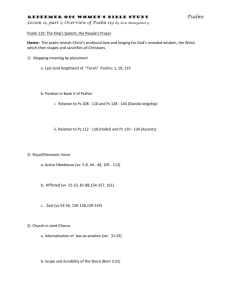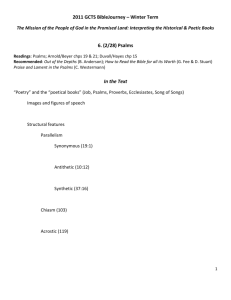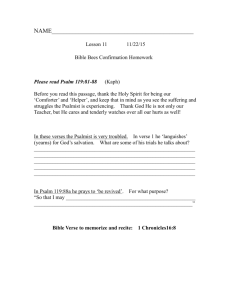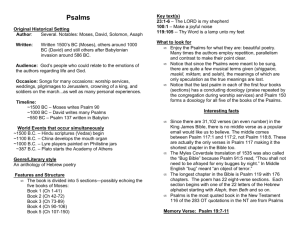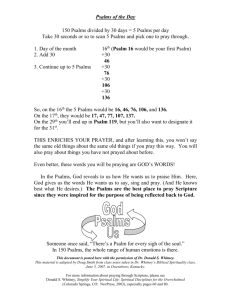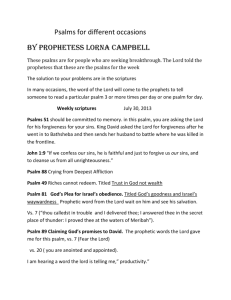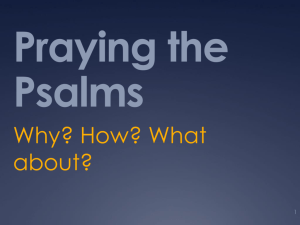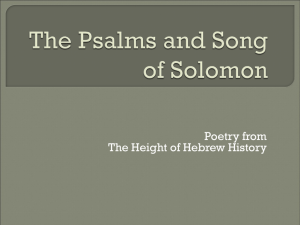Day 4 Post
advertisement
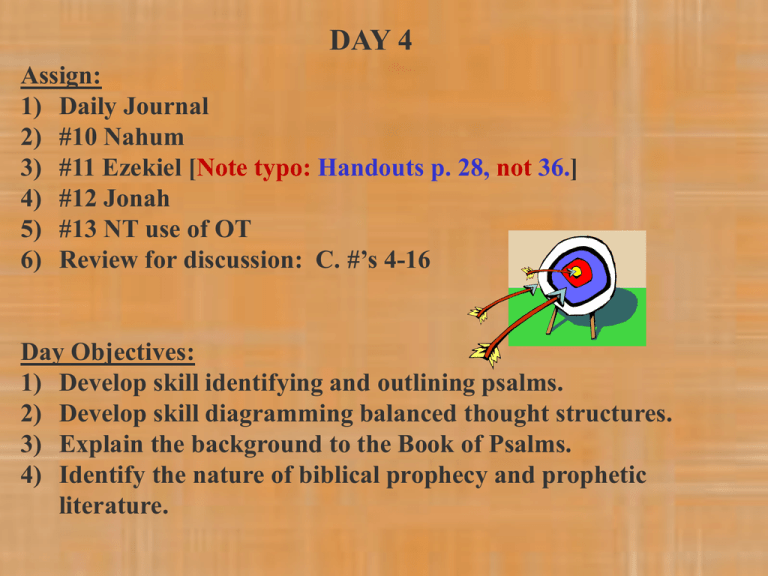
DAY 4 Assign: 1) Daily Journal 2) #10 Nahum 3) #11 Ezekiel [Note typo: Handouts p. 28, not 36.] 4) #12 Jonah 5) #13 NT use of OT 6) Review for discussion: C. #’s 4-16 Day Objectives: 1) Develop skill identifying and outlining psalms. 2) Develop skill diagramming balanced thought structures. 3) Explain the background to the Book of Psalms. 4) Identify the nature of biblical prophecy and prophetic literature. How did the New Testament Writers “Read” the Prophets? [Intro. to Assignment 5) #13 NT use of OT] Main issue: Were the prophetic messages univalent (one meaning or application only) or polyvalent (more than one meaning or application)? Case illustration: Read Matthew 1:18-23 and Isaiah 7:13-16 in its context of the Syro-Ephraimitic War of 734 BCE. Does the prophetic word apply only to Isaiah’s day? Does the prophetic word apply only to Matthew’s day? Does it apply somehow to both times? Functions of the Priesthood (1 of 2) In the OT the people of Israel were called to be holy: NIV Leviticus 20:7-8, "Consecrate yourselves and be holy, because I am the LORD your God. Keep my decrees and follow them. I am the LORD, who makes you holy.” (also 11:44,45; 9:2; 20:7) Idea of consecration of priests, people. Priestly role of “distinguishing”: Leviticus 10:10, “You must distinguish between the holy and the common, between the unclean and the clean.” Called to “make a distinction” and share in the divine creational activity. (Gen 1:4,7) Functions of the Priesthood (2 of 2) Test Question: What is the first petition in the Lord’s Prayer? Point of confrontation: God calls us, as the Church, to reveal His holiness to the world as a royal priesthood and holy people (I Pet 2:9). We bear God’s name; and we are called to reveal His holy character to the world! (Duke) Divine irony: We petition God to make His Name holy, and God says, “OK. I charge you, the new Body of Christ incarnate, the Church, to reveal My holiness.”! DIAGRAMMING “BALANCED THOUGHT STRUCTURES” PSALM 54 (1 of 2) PETITION (1-2) O God, by Your name save me, And by Your power vindicate me! O God, hear my prayer, Give ear to the words of my mouth! LAMENT (3) For strangers have arisen against me, And terrifying ones seek my life; Men who do not set God before them. PSALM 54 (2 of 2) TRUST (4) Behold, God [is] the One who helps me, My Lord [is] the One who upholds my life. PETITION (5) May He return evil to those lurking for me, In Your faithfulness bring to an end them. High Place Altar TRUST: with Vow of Praise (6) and Descriptive Praise (7) With a free-will offering I will sacrifice to You, I will thank Your name, Yahweh, because [it is] good. Because from every trouble You have delivered me, And against my enemies my eye has gloated. PSALM 32 (1 of 2) (Individual Thanksgiving/Declarative Praise) I. Opening Proclamation, 1-2 (Based on what the psalmist has learned: blessed is the one who is forgiven.) A A. Rebellion forgiven/lifted (personal) B B. Guilt covered (objective) B C. Sin not reckoned against (objective) A D. In his spirit no deceit (personal) II.Report of Deliverance, 3-5 A. Trial, 3-4 A 1. I: wasting away due to unconfessed sin, 3 B 2. God: hand was heavy (causing affliction), 4a A 3. I: strength dried up, 4b B. Cry to God: acknowledged/confessed sin, 5ab C. Deliverance: received forgiveness, 5c PSALM 32 (2 of 2) (Individual Thanksgiving/Declarative Praise) III. Conclusion: Instruction & Affirmation, 6-11 A A. Command: pray to God, 6 B B. Affirmation: God will deliver, 7 C C. Intention to instruct, 8 C D. Instruction: do not be without understanding, 9 B E. Affirmation: Yahweh loves those who trust Him, 10 A F. Command: praise God, 11 Psalm 33 (1 of 2) (abbreviated outline) I. II. Call to Praise 1-3 [chiasm: sing, praise, sing] Cause for Praise 4-19 [“word” “deed” “love”] A. Summary: God’s attributes 4-5 B. Illustration: Yahweh’s word and deed 6-12 1. Sovereign over creation 6-9 a. Act of creation 6-7 b. Implication (“therefore”) 8-9 2. Sovereign over history 10-12 a. Actions among nations 10-11 b. Implication 12 C. Illustration: Yahweh’s justice and love 13-19 1. Position of sovereignty over world: knows all 13-15 2. Intervenes in world with justice and love 16-19 Psalm 33 (2 of 2) III. Conclusion: statement of faith 20-22 A. Wait for Yahweh 20 B. Rejoice in Yahweh 21 C. Petition Yahweh in trust 22 Psalm 24 Proclamation of Yahweh’s Ownership of the World 1) To Yahweh belongs the earth and its fullness, the world and all who dwell in it; 2) for He founded it upon the seas and established it upon the rivers. Psalm 24 “Catechism” for Approaching Yahweh 3) Who may ascend the mountain of Yahweh and who may stand in His holy place? 4) One innocent of hands and one pure of heart one who does not lift up his soul to falseness and one who does not swear deceitfully. 5) He receives blessing from Yahweh and vindication from the God of his salvation. 6) Such is the generation of those seeking Him; those seeking Your face are Jacob. Psalm 24 Entrance Liturgy 7) Lift up your heads, O gates, A and lift yourselves up, O ancient doors, so that the glorious King may enter! 8) Who is the glorious King? B Yahweh, powerful and mighty; Yahweh, mighty in battle! 9) Lift up your heads, O gates, A and lift up, O ancient doors, so that the glorious King may enter! 10) Who is this glorious King? B Yahweh of hosts; He is the glorious King! Damascus Gate in Jerusalem PSALM 56 (What type of Psalm?) Look for chiasm Verses 3-4 (Trust Section) A) When I am afraid When I am afraid, B) In You I will trust C) in God In You I will trust. D) whose word I praise In God, whose word I praise, C) in God B) I do trust In God, I do trust; I will not be afraid. A) I will not be afraid [What can flesh do to me?] [Therefore:] What can flesh do to me? PSALM 56 Look for chiasm Verses 9-11 (2nd Trust Section) Then my enemies will turn back, in the day I cry out; This I know: that God is for me. In God I will praise [His] word, I Yahweh I will praise [His] word. In God I do trust, I will not fear; What can man do to me? PSALM 56 Look for chiasm Verses 9-11 (2nd Trust Section) Then my enemies will turn back, in the day I cry out; This I know: that God is for me. In God I will praise [His] word, I Yahweh I will praise [His] word. In God I do trust, I will not fear; What can man do to me? PSALM 56 Verses 9-11 (2nd Trust Section) A) Then my enemies will turn back, B) In the day I cry out; C) This I know: that God is for me. D) In God I will praise [His] word, D) I Yahweh I will praise [His] word. C) In God I do trust, B) I will not fear; A) What can man do to me? Literary Features (1 of 2) (Handouts, p. 22) I. General A. poetic: 1. Densely packed 2. parallelism (balanced thought structures) 3. figurative language (e.g. hyperbole, metaphor, simile, personification, merism) 4. graphic, picturesque language B. "lofty" (theological) C. intensely personal language (testimonial; bold, honest, emotional, emphatic) D. direct address E. questions and answers (etc.) READING STRATEGY (1 of 3) (Handouts, p. 23) Analyze (Many of the "steps" are not sequential, but simultaneous.) 1. Identify type of psalm. 2. Seek to recover historical and cultic setting. 3. Outline the general structure. a. What are the main sections and their motifs? b. What is the connection/flow of thought among sections? 4. Identify the flow of thought and topics within each section. 5. Identify/diagram the structural patterns among the verses. What impact are these structures meant to have? 6. Identify/diagram the parallelism (balanced structures) within verses. What are the relationships between the balanced elements? 7. Identify the figures of speech and explore how each one "works." 8. Focus on the graphic language and ask what it is meant to evoke. (Discover the emotive, conative and persuasive elements.) READING STRATEGY (2 of 3) 9. Look for allusions to other OT events and texts. What would this relationship indicate? 10. If the title/superscription gives a setting (eg. in the life of David), look up that event and explore what this perspective would add to the themes and mood of the psalm.* *This step moves away from a form-critical reading to a “historical” reading. Synthesize 1. What is/are the psalmist's intention/s? 2. What is the psalmist's situation (personally, cultically)? 3. What is the psalmist feeling and experiencing? 4. What is/are the psalmist's thesis/theses? READING STRATEGY (3 of 3) Application 1. Can I identify or empathize with the psalmist's situation and/or feelings? 2. What is the psalmist teaching about the God-humanity relationship and/or about how life works? 3. Can/should this psalm provide a model for me when speaking to God or others about God? UNIT 3. BACKGROUND ON PSALMS (1 of 8) (Handouts, pp. 24-27) I. Historical Context A. Relationship to ancient Near East hymnic literature 1. Similar: cultic function; style; content of petitioning, lamenting, praising; (types?) 2. Difference: theology and world-view; no mythic enactment B. Authorship/Origin 1. Cannot be certain of specific author from title 2. Debate about personal vs. cultic origin C. Setting of transmission and employment 1. Transmission and preservation: temple functionaries 2. Employment: cultic rituals connected w/Temple D. Role of Priests and Levites: 1. Preserved and taught the Law (late stage?) 2. Guided & guarded the cultic rituals: sacrifice, worship, music (pastoral role?) UNIT 3. BACKGROUND ON PSALMS (2 of 8) II. Psalms Outside the Psalter (particularly in prophets) 1. Ex. 15:1-18, 20-21, (Song of the Sea). 2. Dt. 32:1-43, (Song of Moses). 3. Jdg. 5:1-31, (Song of Deborah). 4. 1 Sam. 2:1-10, (Song of Hannah). 5. 2 Sam. 22:2-51, (Psalm of David, also Ps. 18). 6. Isa. 12:4-6, (Thanksgiving). 7. Isa. 39:9-20, (Song of Hezekiah). 8. Isa. 42:10-12; 52:1-10. 9. Hab. 3:2-19, (Hymn of Praise). 10. Jonah 2:1-9 (Jonah's Prayer from the Belly of the Fish). 11. Job 5:8-16; 9:10-14; 12:7-10, 13-25 (Hymns); 3:3-12, 13-19, 20-26; 7:1-10, 12-21; 9:2-31; 10:1-22 (Laments.) 12. Jer. 15:15-18; 17:14-18; 18:9-23, (Laments) also Lam. Ch. 3,5. Read Jonah 2:2-9 What type of Psalm is this? UNIT 3...BACKGROUND ON PSALMS (3 of 8) III. Growth of Psalter A. 1st stage: individual psalms B. 2nd stage: superscriptions/titles C. 3rd stage: collected according to titles (cf. Ps 72:20) by Levitical priests who were responsible for music (?) Collections of Psalms Within the Psalter 1. Davidic Collection, 3-41. 2. Korah Musical Guild, 42-49. 3. Davidic Collection, 51-72. 4. Asaph Musical Guild, 73-78, Ps. 50. 5. Various Musical Guilds, 84-89. 6. Various Other Collections, 90-150, including (a) Psalms of Yahweh's Kingship, 93-99. (b) Psalms of Pilgrimage, 120-134. (c) Hallelujah 104-106, 111-113, 135, 146, 150. UNIT 3. BACKGROUND ON PSALMS (4 of 8) D. 4th stage: collection into “books” Book 1: Psalms 1-41 Concluding Doxology, 41:13 Book 2: Psalms 42-72 Structure of the Psalter God/Elohim Lord/Yahweh 15 272 164 30 14 370 Elohistic Psalter Concluding Doxology 72:18-19 Book 3: Psalms 73-89 Concluding Doxology 89:52 Book 4: Psalms 90-106 Concluding Doxology 106:48 Book 5: 107-150 Concluding Doxology for entire Psalter, Psalm 150 Read Psalms 14 and 53. What do you observe? UNIT 3. BACKGROUND ON PSALMS (5 of 8) D. 4th stage: collection into “books” (cont.) Note parallel psalms/sections: Ps 14 = Ps 53 Ps 40:13-17 = Ps 50 Ps 57:7-11 +Ps 60:5-12 = Ps 108 E. 5th Stage: Five Book Arrangement Pss 1-2 - Introduction Pss 145-50 - Finale (3-year lectionary cycle, 4 per Sabbath?) UNIT 3...BACKGROUND ON PSALMS (6 of 8) IV. Superscriptions/Titles (126 psalms) [any postscripts?] A. Types of information: 1. linked to person with lamed (to, for, by) 2. technical name for psalm types 3. musical terms 4. melody indicators 5. liturgical indicators 6. historical connection to life of David B. Evaluation: 1. SEEM to be secondary 2. Cannot safely assume lamed (A 1) means author 3. May be useful to read in light of historical notices (See Psalm 51) UNIT 3...BACKGROUND ON PSALMS (7 of 8) V. Theological Basis and/or Implications Each psalm has own distinct message; but some generalizations: A. Petitions: 1. God is to be approached boldly, with complete openness 2. Even in despair, the psalmist expressed trust B. Thanksgivings: 1. God is to be thanked by testimony before community in celebration 2. God is experientially knowable 3. Faith in God who acts on their behalf C. Hymns: 1. 2. God is worthy of praise God, who is majestic and sovereign, graciously condescends to care for those who trust God UNIT 3...BACKGROUND ON PSALMS (8 of 8) VI. Principles for Application A. Can I identify or empathize with the psalmist's situation and/or feelings? (subjective) B. Can/should this psalm provide a model for me when speaking to God or others about God? (subjective) Caution: elements of imprecation C. What is the psalmist teaching about the God-humanity relationship and/or about how life works? (objective) Caution: not the same as explicitly taught doctrine Personal Summary B. 6. Obj.: Reflect on the value of the hymnic literature for Christian faith and practice. (W) Based on the above assignments regarding the Psalms and Temple worship, explain, as if speaking to a member of your congregation, why it is valuable for Christians to read and study the Psalms. PROPHETIC LITERATURE How did the New Testament Writers “Read” the Prophets? [Intro. to Assignment 5) #13 NT use of OT] Main issue: Were the prophetic messages univalent (one meaning or application only) or polyvalent (more than one meaning or application)? Case illustration: Read Matthew 1:18-23 and Isaiah 7:13-16 in its context of the Syro-Ephraimitic War of 734 BCE. Does the prophetic word apply only to Isaiah’s day? Does the prophetic word apply only to Matthew’s day? Does it apply somehow to both times? C. 1. Obj.: Explore why and how prophetic words might have been recorded. (Case study) Speculate: a) (T) For what reasons, by whom, and in what form might this message have been preserved initially? How much would you expect the initial preservation to agree in form and content with what was literally spoken? b) (T) For what reasons, by whom, and in what form would this account have been preserved for later generations? How much would you expect this later account to agree in form and content with the first account? c) (W) What would you as a modern audience need to do or find out in order to understand the message as fully as possible? What comparisons and contrast to this process would you expect to apply to the message of the biblical prophets? Point: Following generations must have believed that what happened had continuing meaning/application. They preserved the account. C. 2. Obj.: Form an overview of OT Prophets and Prophecy. Prequestion (W): Define "prophet," and "prophecy" based on your own understanding. Read a Bible dictionary article on “prophets, prophecy.” (W) Explain how your definitions would change. If they would not change, what is something new that you learned? Prophetic Books: Difficulties (1 of 3) Factors which make them difficult to read: a) Not designed as "books" in modern sense. They are deposits or collections of the messages and activities of prophets along with historical and biographical elements. b) Oracular style (poetic speeches) full of images and allusions difficult for modern audience to follow. c) The speeches were for specific occasions, the details of which are often lost; and were subsequently written for use by secondary audiences (i.e. they have been moved from an oral, specific context into a written more general context). It is difficult to reconstruct the original setting of the prophet's activities and speeches. (Like listening in to one half of a phone call.) Prophetic Books: Difficulties (2 of 3) Hello. Hi Shawn. This is Pat. Hi, Pat. How're you doing? Well not too well at the moment. I was calling to ask how much mayonnaise goes on top of that 7-layer salad you told me about. But I had just cut my finger chopping up some celery and didn’t realize until after I dialed your number that it’s bleeding pretty badly. Oh, that sounds bad. Do you think you will be able to stop the bleeding or will you need stitches? I'm going to have to run to the sink and see if I can get this stopped. I hope I won't need any stitches. But first, how much mayonnaise do I need? Well then, as I recall you need to put 1/2 cup of mayonnaise on top of it. Thanks. Gotta run. Okay. Bye. Prophetic Books: Difficulties (3 of 3) d) They have often been shaped by two processes: 1) the original ministry and message(s) of the prophet, and 2) the selective arranging process of later editors producing a "book" with a new form and message. It is now often difficult to reconstruct the process of development of a prophetic book into the final written form and get back to the original historical setting and original purpose. The community of faith was not interested in historical reconstruction as much as application!
